
The Rijksmuseum is a Dutch national museum dedicated to arts and history in Amsterdam. The museum is located at the Museum Square in the borough Amsterdam South, close to the Van Gogh Museum, the Stedelijk Museum Amsterdam, and the Concertgebouw.
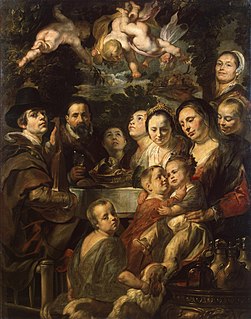
Jacob (Jacques) Jordaens was a Flemish painter, draughtsman and tapestry designer known for his history paintings, genre scenes and portraits. After Peter Paul Rubens and Anthony van Dyck, he was the leading Flemish Baroque painter of his day. Unlike those contemporaries he never travelled abroad to study Italian painting, and his career is marked by an indifference to their intellectual and courtly aspirations. In fact, except for a few short trips to locations in the Low Countries, he remained in Antwerp his entire life. As well as being a successful painter, he was a prominent designer of tapestries.
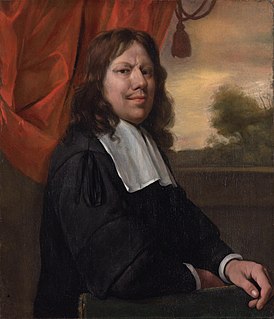
Jan Havickszoon Steen was a Dutch Golden Age painter, one of the leading genre painters of the 17th century. His works are known for their psychological insight, sense of humour and abundance of colour.
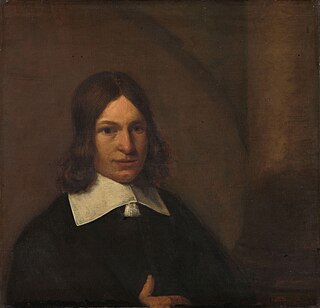
Pieter de Hooch was a Dutch Golden Age painter famous for his genre works of quiet domestic scenes with an open doorway. He was a contemporary of Jan Vermeer in the Delft Guild of St. Luke, with whom his work shares themes and style.
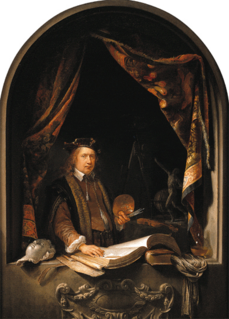
Gerrit Dou, also known as Gerard and Douw or Dow, was a Dutch Golden Age painter, whose small, highly polished paintings are typical of the Leiden fijnschilders. He specialised in genre scenes and is noted for his trompe l'oeil "niche" paintings and candlelit night-scenes with strong chiaroscuro. He was a student of Rembrandt.

Jan Davidsz. de Heem or in-full Jan Davidszoon de Heem, also called Johannes de Heem or Johannes van Antwerpen or Jan Davidsz de Hem, was a still life painter who was active in Utrecht and Antwerp. He is a major representative of that genre in both Dutch and Flemish Baroque painting.

Bartholomeus van der Helst was a Dutch painter. Considered to be one of the leading portrait painters of the Dutch Golden Age, his elegant portraits gained him the patronage of Amsterdam's elite as well as the Stadtholder's circle. Besides portraits, van der Helst painted a few genre pictures as well as some biblical scenes and mythological subjects.

The Feast of Saint Nicholas, is a painting by Dutch master Jan Steen, which can now be found in the Rijksmuseum in Amsterdam. It measures 82 x 70.5 cm. The picture, painted in the chaotic Jan Steen "style," depicts a family at home on December 5, the night celebrated in the Netherlands as the Feast of Saint Nicholas, or Sinterklaas.

Adriaen Hanneman was a Dutch Golden Age painter best known for his portraits of the exiled British royal court. His style was strongly influenced by his contemporary, Anthony van Dyck.

Matthys or Matthijs Naiveu was a Dutch Golden Age painter.

Depictions of tobacco smoking in art date back at least to the pre-Columbian Maya civilization, where smoking had religious significance. The motif occurred frequently in painting of the 17th-century Dutch Golden Age, in which people of lower social class were often shown smoking pipes. In European art of the 18th and 19th centuries, the social location of people – largely men – shown as smoking tended to vary, but the stigma attached to women who adopted the habit was reflected in some artworks. Art of the 20th century often used the cigar as a status symbol, and parodied images from tobacco advertising, especially of women. Developing health concerns around tobacco smoking also influenced its artistic representation. Recently tobacco has impacted on art in a quite different way, with the conversion of many cigarette vending machines into Art-o-mat outlets, selling miniature artworks the shape and size of a cigarette packet.
Richard Brakenburgh or Brakenburg, was a Dutch Golden Age painter.

Peeckelhaeringh, or Pekelharing, refers to an old Dutch word for pickled herring. Today it is best known as a jester by the same name who was the subject of a painting by Frans Hals.
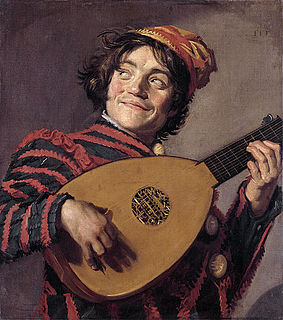
The Lute Player refers to a painting from 1623 or 1624 now in the Louvre by the Haarlem painter Frans Hals, showing a smiling actor wearing a jester's costume and playing a lute.

Merry company is the term in art history for a painting, usually from the 17th century, showing a small group of people enjoying themselves, usually seated with drinks, and often music-making. These scenes are a very common type of genre painting of the Dutch Golden Age and Flemish Baroque; it is estimated that nearly two thirds of Dutch genre scenes show people drinking.
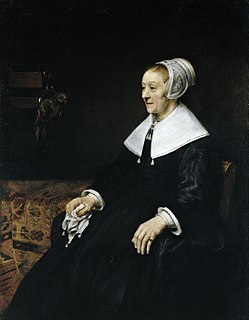
Portrait of Catharina Hooghsaet (1607–1685) is a 1657 painting by the Dutch Golden Age painter Rembrandt.

A Mayor of Delft and his Daughter (1655) is the common name of an oil on canvas painting by the Dutch painter Jan Steen. It is an example of Dutch Golden Age painting and is part of the collection of the Rijksmuseum. Since 2006 it has been determined that a more historically correct title is Double portrait of Adolf Croeser (1612-1668) and his daughter Catharina Croeser (1642-....).

Children Teaching a Cat to Dance or The Dancing Lesson is a c.1660–1679 oil on panel painting by Jan Steen, now in the Rijksmuseum in Amsterdam.

The Oyster Eater or Girl Offering Oysters, is a c.1658-1660 small oil on panel painting by Jan Steen. Since 1936, it has been in the collection of the Mauritshuis in the Hague. This is a genre painting that demonstrates Steen's more intricate style and use of domestic settings. It also shows Steen's use of symbolism with oysters to create a theme of earthly lust.

Soo voer gesongen, soo na gepepen is a c.1668–1670 oil-on-canvas painting by Dutch artist Jan Steen, that is currently featured in the Mauritshuis museum in The Hague. The painting is a celebratory holiday scene that depicts three generations of a Dutch family, and serves as an allegory about parental examples, vice, and influence. This subject has been painted thirteen times by Jan Steen and has also been known as The Cat Family, or Jan Steen's Family. Of the many renditions, the Mauritshuis version is considered to be the exemplar of the series.



















